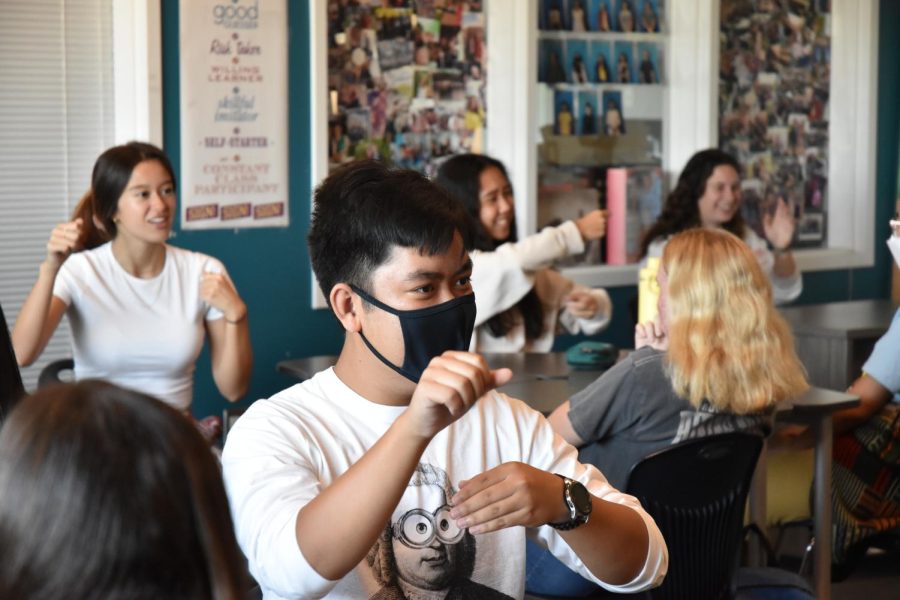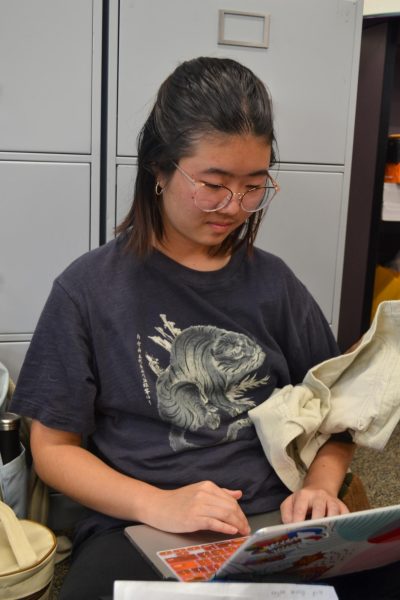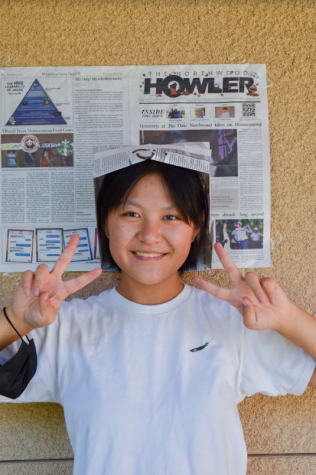Achieving inclusivity by learning American Sign Language
A LOVING LANGUAGE: Senior Bruce Duong practices ASL by describing the short film “The Black Hole” to his partner during class.
October 31, 2022
Imagine a group of friends and family gathered at a dinner table suddenly burst out laughing. When a d/Deaf person asks what was funny, they are usually told “It’s nothing” or “I’ll tell you later.” But the d/Deaf person* feels excluded at the table and later, the comment is no longer funny.
An inability to hear is not the problem in this situation; d/Deaf people are capable of communication. Therefore, hearing people should put in the effort to learn how to appropriately communicate with the Deaf community in America with basic American Sign Language.
Hearing people often do not understand how to appropriately communicate with d/Deaf people and incorrectly assume or expect them to be capable of reading lips. However, only 30-40% of what is spoken can be lipread, even under the best conditions, and one typically needs more information to understand what is being communicated.
Especially when dinner tables are not set up to have optimal conditions for lipreading, attempting to understand a conversation becomes extremely draining and leads to information loss. The problem of a communication barrier goes beyond just the scenario described above, called the Dinner Table Syndrome; d/Deaf people often experience an emotional toll from being unable to communicate, leading them to disengage which puts them at a higher risk for depression and anxiety.
With 10 million hard of hearing and 1 million d/Deaf people in the United States, the hearing population should be equipped and prepared to communicate with the Deaf community properly while also keeping in mind the variety of communication methods within this community; Hard of hearing individuals may choose to lip read and listen with residual hearing, while other d/Deaf individuals may choose to write or sign to communicate with a hearing person.
Learning a new language (even if just for simple conversations) and the basics of how to best interact with d/Deaf people takes time and effort. Fortunately, students don’t have to look any farther: here at Northwood, students can enroll in Michele Pierce’s ASL classes for up to three years.
“My number one goal is that my students leave the program as an advocate for the Deaf community,” Pierce said. “I find it important to learn ASL because it gives you the opportunity to communicate with a minority population, bridging the gap between the hearing and Deaf world.”
Northwood’s ASL club is another opportunity students should utilize to educate themselves, regardless of whether or not they are enrolled in the class. Meetings are held every other Friday in Room 1426 during lunch, and announcements can be found on the club’s Instagram @nhs_aslclub.
At meetings, board members teach holiday-themed signs and spread awareness about current events through presentations, like September’s International Week of the Deaf. Current ASL students can look forward to study sessions for tests or projects.
“Don’t be afraid to join the club if you don’t know ASL,” club president senior Neela Michelsen said. “We try our best to be very inclusive and teach signs before playing games so that people can participate.”
Ultimately, the hearing population needs to put in the work to improve accessibility and inclusivity for d/Deaf individuals. Beyond the classroom, people can utilize online resources to learn conversational ASL such as the ASL University’s website lifeprint.com or their YouTube channel “Bill Vicars” for many lessons about the language, Deaf history and culture.



![AAAAAND ANOTHER THING: [CENSORED] [REDACTED] [BABY SCREAMING] [SIRENS] [SILENCE].](https://thehowleronline.org/wp-content/uploads/2025/06/lucy-1200x800.jpg)


















































![AAAAAND ANOTHER THING: [CENSORED] [REDACTED] [BABY SCREAMING] [SIRENS] [SILENCE].](https://thehowleronline.org/wp-content/uploads/2025/06/lucy-300x200.jpg)



